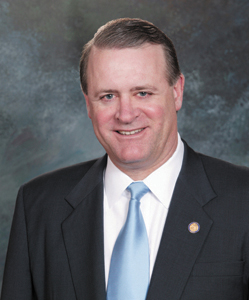STRAIGHT FROM THE SENATE
 UNDERSTANDING YOUR PAIN AT THE PUMP AND WHAT MAKES GASOLINE PRICES SO HIGH
UNDERSTANDING YOUR PAIN AT THE PUMP AND WHAT MAKES GASOLINE PRICES SO HIGH
In 1950, the first year AAA Hoosier Motor Club published a study on driving costs, the average price for a gallon of gas was 27 cents.
Our world has changed dramatically since then. This year, Indiana was one of 17 states to see gas prices top the $4-per-gallon mark. They’ve gone down some since then, but with the market still volatile, it’s important for us to know just what causes our pain at the pump and what we can do about it.
One thing’s for sure – much of it is out of the control of your local gasoline station or convenience store owner. The Institute For Energy Research says a gallon of gas breaks down price-wise like this:
•8 percent distribution and marketing,
•8 percent refining,
•12 percent taxes, and
•72 percent crude oil.
Jeff Lenard, spokesman for the National Association of Convenience Stores, estimates that gasoline accounts for 70 percent of a typical station’s revenues, but only 30 percent of its profits. Paul Fiore, executive director of the Service Station Dealers of America, a trade association for gas retailers offering auto repairs and maintenance, said the mix is about the same for service stations.
Some convenience store owners say they make more on a cup of coffee than a gallon of gas.
It wasn’t long ago that gas in Indiana was under $3. It cost $2.96 a gallon as recently as December 21, 2010. It was $2.58 on August 27, 2010 and $2.93 a year ago this month.
Why did gas prices rise so high so quickly? You’d have to take a trip across the globe to get at some of the root causes.
Increased mobility in China and India is having a profound effect on the global market. While the two countries made up just over one-tenth of world oil consumption in 2006, together they accounted for one-quarter of consumption growth. In 2009, China alone was responsible for about a third of the world’s oil consumption growth.
Meanwhile, here at home, the ability to refine petroleum products domestically has decreased dramatically. In 1981, the U.S. had 324 refineries processing 18.6 million barrels per day. As of January 2010, there were just 148 refineries (but only 137 operating) with a capacity of 17.6 million barrels per day.
So when you combine the higher international demand with our lower levels of U.S. refining capacity, gas prices have nowhere to go but up. U.S. gasoline went from $1.06 to $2.57 between 1998 and 2006.
We are certainly not alone in our pain at the pump:
• India’s price per gallon rose over 19 percent between 2003 and 2005;
• China’s price per gallon rose 73 percent between 2001 and 2006; and
• Canada’s price increased from $1.38 to $3.26 between 1998 and 2006.
It may get worse before it gets better. The International Energy Association predicts that by 2035, three-quarters of the world’s oil production from existing fields will need to be replaced.
That’s a sobering thought, considering the Motor and Equipment Manufacturer’s Association says Americans drive nearly three trillion miles per year. Some estimates say the U.S. consumes 400 million gallons of gasoline every day.
That’s why Indiana has been aggressive at alternative fuel production.
In less than two years, Indiana has moved to preeminence in the production of alternative fuels. Indiana had one ethanol plant and no biodiesel plants in January of 2005. Today, 13 ethanol plants and five biodiesel plants are operating in the Hoosier state. These plants produce more than 1.1 billion gallons of ethanol and approximately 118 million gallons of biodiesel annually.
While that’s certainly not going to remedy all of our pain at the pump, at least Indiana is trying to do what it can to loosen the reins of dependency on foreign oil.
As President Pro Tem of the Senate, I will continue doing everything I can with my colleagues to encourage alternative fuel production. In the meantime, driving less aggressively, observing the speed limit, using cruise control, maintaining your vehicle, particularly with engine tune-ups and tire pressure checks, removing excess weight and avoiding long periods of idling are good remedies for reducing some of our pain at the pump.
- THANK YOU INDIANA, IT HAS BEEN AN HONOR – Straight From The Senate - November 9, 2018
- CYBERSECURITY AWARENESS MONTH – Straight From The Senate - October 26, 2018
- INDIANA’S ECONOMY IS THRIVING – Straight From The Senate - October 12, 2018


